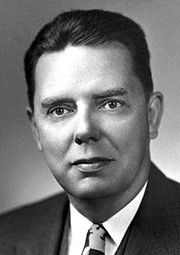
Back فيليب هنش Arabic فيليب هنش ARZ ادوارد کالوین کندال AZB Філіп Хенч Byelorussian Филип Хенч Bulgarian Philip Showalter Hench Catalan فیلیپ شۆوڵتەر ھینچ CKB Philip Showalter Hench Czech Philip Showalter Hench German Φίλιπ Σόγουολτερ Χεντς Greek
Philip Showalter Hench | |
|---|---|
 Hench in 1950 | |
| Born | February 28, 1896 |
| Died | March 30, 1965 (aged 69) |
| Nationality | American |
| Alma mater | Lafayette College University of Pittsburgh |
| Known for | Discovery of cortisone |
| Awards | Nobel Prize in Physiology or Medicine (1950) |
| Scientific career | |
| Fields | Medicine |
| Institutions | Mayo Clinic |
| Signature | |
Philip Showalter Hench (February 28, 1896 – March 30, 1965[1]) was an American physician. Hench, along with his Mayo Clinic co-worker Edward Calvin Kendall and Swiss chemist Tadeus Reichstein was awarded the Nobel Prize for Physiology or Medicine in 1950 for the discovery of the hormone cortisone, and its application for the treatment of rheumatoid arthritis. The Nobel Committee bestowed the award for the trio's "discoveries relating to the hormones of the adrenal cortex, their structure and biological effects."[2]
Hench received his undergraduate education at Lafayette College in Easton, Pennsylvania, and received his medical training at the United States Army Medical Corps and the University of Pittsburgh. He began working at Mayo Clinic in 1923, later serving as the head of the Department of Rheumatology. In addition to the Nobel Prize, Hench received many other awards and honors throughout his career. He also had a lifelong interest in the history and discovery of yellow fever.
- ^ Philip S. Hench on Nobelprize.org , accessed 2 May 2020
- ^ "The Nobel Prize in Physiology or Medicine 1950". The Nobel Foundation. Retrieved 2011-07-04.
© MMXXIII Rich X Search. We shall prevail. All rights reserved. Rich X Search